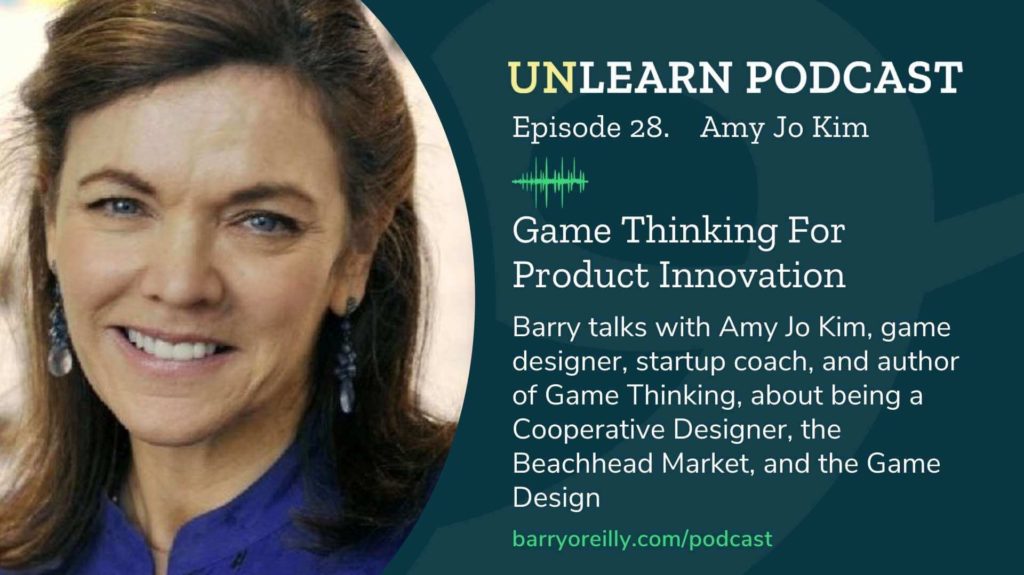Barry O’Reilly is excited to welcome Amy Jo Kim to this week’s Unlearn Podcast. Amy is a game designer, startup coach, and author of Game Thinking. She has worked on the early design teams of games such as Rock Band and The Sims, and has helped many companies, including Netflix and eBay, find their customers to help them scale.
A Cooperative Designer
Amy describes herself as a social game designer. She is enthusiastic about teamwork, having learned many lessons about creating a collaborative environment from working in music bands and modeling great bandleaders. One of those lessons that she now teaches in her Team Accelerator program is how to “make everything gel so we don’t even remember whose idea it was… just getting the work done in a really focused yet creative way.” [Listen from 3:00]
Many opportunities opened up for her Amy when she found a tribe of like-minded people. She tells Barry that she found mentors that she could click with and saw a way that she could contribute immediately to a much larger team. [Listen from 8:10]
“The best use of any game mechanics is to support the customer journey.” – Amy Jo Kim
Go After The Early Beachhead
“…If you’re innovating you can’t just go after your average customer in that market,” Amy posits. “You have to capture this narrow early beachhead market first.” As early as 1961, Everett Rogers of Bell Labs found that innovations always start by capturing the early market before going into the early and later mainstream. Amy has taken these insights from innovators like Rogers, Jeffrey Moore, and Will Wright, and made them accessible through a step-by-step program. She shares how these principles were lived out in building out The Sims, and in companies such as eBay and Netflix. “…There’s so much you can learn and get out of iterating ideas with [your early beachhead] that it gets you to a point where you can get a vector in the direction and build out for the next layer of people around them,”Amy adds. [Listen from 15:30]
Early adopters or beachheads have these three characteristics:
They actually have the problem that your product solves;
They know they have the problem and are willing to try anything that might help;
They’re taking actions that demonstrate they’re trying to solve the problem. [Listen from 25:40]

Game Design Is About Customer Journey
The best game designers create a customer journey and then use mechanics such as gamification to deliver that journey. While shaping behavior with rewards – the basis of gamification – may deliver short-term lift, it does not provide long-term engagement. Barry comments that tapping into intrinsic motivation is a delineation towards game thinking. Step one in designing for intrinsic motivation, Amy says, “is understanding that the best use of any game mechanics or progression mechanics is to support a journey.” [Listen from 27:40]
The framework Amy details in her book gives a synthesized approach to building an engaging customer journey. The core, she says, is how your product transforms the user into the person they want to be. “If you think about creating a product that gets better as the customer becomes more skilled, you’ll be really getting to the heart of it.” Barry comments that Amy’s work is about helping the person to be the best they can be, realizing that struggle is part of the journey. “All the best things we do in life,” Barry says, “requires to test our character, to cultivate skills and behaviours in ourselves that we don’t have, to grow as individuals.” [Listen from 31:45]
The mental model – the story that’s unfolding in the customer’s head – is at the heart of intrinsic motivation, Amy points out. She advises mapping out the story building up in the customer’s mind to understand their point of view. This will drive retention, she says. [Listen from 36:00]
Looking Ahead
Amy is excited about the explosion of creativity that’s being unleashed because of the pandemic. She says that it’s “so much good that’s happening for the planet.”















